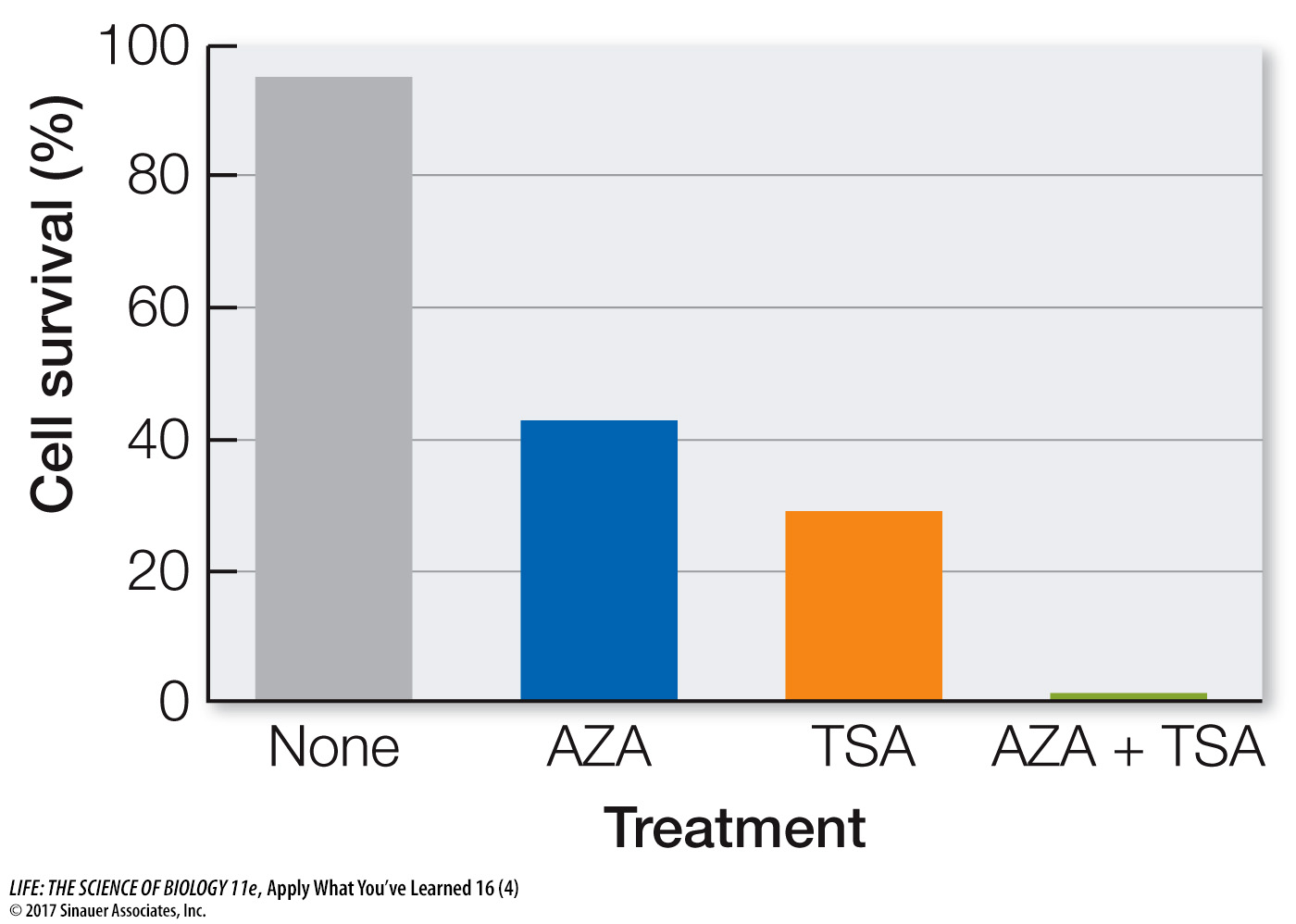Apply What You’ve Learned
Review
16.4 Methylation of cytosine bases in DNA can enhance the binding of repressor proteins to promoter regions, resulting in silencing of gene expression.
16.4 Acetylation and deacetylation of histone proteins alter the affinity of the histones for DNA, changing the accessibility of regions of the DNA to RNA polymerase.
Original Paper: Bovenzi, V. and R. L. Momparler, 2001. Antineoplastic action of 5-
Cancer cells do not stop dividing. In some types of cancer, this happens because oncogenes that signal the go-
Recall that DNA methyltransferase adds methyl groups onto cytosines in DNA, while a demethylase catalyzes the reverse reaction. Methylation of promoter regions in DNA inhibits gene expression; demethylation activates gene expression.

Recall, too, that chromatin can undergo remodeling as histones undergo reversible acetylation and deacetylation of lysine residues. Acetylation of histones activates gene expression; deacetylation inhibits gene expression.
358

With this in mind, the researchers decided to treat the breast cancer cells with two different inhibitors: AZA, a compound that inhibits DNA methyltransferase; and TSA, a compound that inhibits histone deacetylase. The researchers looked at the effects of both inhibitors, first separately and then together (see graph at right), on the growth of the cancer cells.
In another experiment, the researchers measured the expression of two genes that have been shown to be silenced in these cancer cells. At the beginning of the experiment, cancer cells were either incubated with each inhibitor separately or with the two inhibitors combined. The researchers then isolated RNA from the cells and used the polymerase chain reaction (PCR) to amplify mRNA that had been expressed from the genes of interest. They compared the quantities of the amplified products, which were proportional to the quantities of the original mRNA transcripts that had been expressed in the cells during their treatment. The results are shown in the table below.
| Untreated control of mRNA transcript of: |
Treatment | |||
|---|---|---|---|---|
| AZA | TSA | AZA + TSA | ||
| Gene 1 | 7 | 23 | 25 | |
| Gene 2 | <1 | <1 | 11 | |
Questions
Question 1
Analyze the results shown for the single drugs. What do the data suggest about the roles of DNA methylation and histone deacetylation in gene expression in this cell line?
An inhibitor of DNA methylation restores tumor suppressor activity in the cancer cells. The same effect is observed with an inhibitor of histone deacetylation. These results suggest that both DNA methylation and histone deacetylation operate to shut down expression of genes that suppress tumor growth.
Question 2
Analyze and explain the results shown for both drugs together as they compare with the results for the single drugs. What do the results suggest about the combined effect of DNA methylation and histone acetylation on gene expression in these cells?
The data show that inhibitors of both histone deacetylation and DNA methylation act together with greater effect than either inhibitor alone. This suggests that some gene expression is inhibited by DNA methylation, some by histone deacetylation, and some by both processes. In this last group of genes, both inhibitors must be required to release the genes from being silenced.)
Question 3
Analyze the gene expression data in the table. What do these data suggest about the mechanism of silencing of each gene?

Gene 1 can be reactivated by either inhibitor, but Gene 2 can be reactivated only by a combination of the two inhibitors. For Gene 1, the extent of DNA methylation and histone deacetylation may not be great. In this case, either DNA demethylation or histone acetylation may tip the balance just enough to alter the nucleosome to allow access of RNA polymerase to bind to the promoter and express the gene. In the case of Gene 2, RNA polymerase may be prevented from binding to the promoter for two reasons: the promoter site could be heavily methylated and histones could also be deacetylated, thus preventing loosening of the nucleosome to expose the promoter region. Therefore, for Gene 2 both DNA methylation and histone deacetylation must be inhibited for expression to be restored.